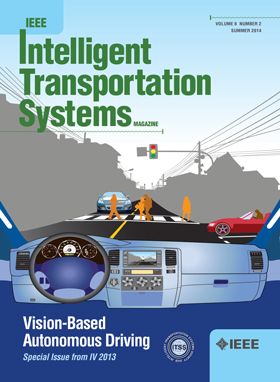Time Series Anomaly Detection in Vehicle Sensors Using Self-Attention Mechanisms
IF 7.9
1区 工程技术
Q1 ENGINEERING, CIVIL
IEEE Transactions on Intelligent Transportation Systems
Pub Date : 2024-09-02
DOI:10.1109/TITS.2024.3415435
引用次数: 0
Abstract
Connected autonomous vehicles (CAVs) offer significant enhancements in coordinated traffic and safety through real-time vehicle-to-vehicle or vehicle-to-infrastructure communications, establishing them as a potent tool for augmenting driving tasks. However, the extensive information-sharing framework inherent in CAVs amplifies the risk associated with sensor anomalies, posing challenges to the reliability and security of the system. Responding to this timely research challenge, this study proposes a novel anomaly detection method, namely Dual-channel Self-attention-based Convolutional Neural Network (DSA-CNN) for multivariate time series data. Through the introduction of the Dual-channel Self-attention Mechanism, DSA-CNN can progressively and autonomously extract spatiotemporal features from multivariate time series data. The proposed method was tested under a variety of common threatening sensor anomaly patterns of CAVs summarised in the literature, and evaluated under multiple different performance metrics. The results demonstrate its advantages in detecting minor anomalies and enhancing sensitivity, outperforming previously reported methods in the literature. Across all experimental scenarios, an average sensitivity improvement of 2.53% was observed, complemented by an average F1 score increase of 1.47%. In CAV settings, maintaining high sensitivity to ensure fewer undetected anomalies, alongside the ability to detect small anomalies, can be more important for the robustness and safety measures of CAV systems.利用自我关注机制进行车辆传感器时间序列异常检测
互联自动驾驶车辆(CAV)通过实时的车辆间或车辆与基础设施间通信,大大提高了协调交通和安全性,使其成为辅助驾驶任务的有力工具。然而,CAV 固有的广泛信息共享框架扩大了与传感器异常相关的风险,给系统的可靠性和安全性带来了挑战。为了及时应对这一研究挑战,本研究提出了一种新型异常检测方法,即针对多元时间序列数据的双通道自注意卷积神经网络(DSA-CNN)。通过引入双通道自注意机制,DSA-CNN 可以逐步自主地从多变量时间序列数据中提取时空特征。我们对文献中总结的各种常见的 CAV 威胁传感器异常模式进行了测试,并根据多个不同的性能指标对所提出的方法进行了评估。结果表明,该方法在检测轻微异常和提高灵敏度方面具有优势,优于之前文献中报道的方法。在所有实验场景中,灵敏度平均提高了 2.53%,F1 分数平均提高了 1.47%。在 CAV 环境中,保持高灵敏度以确保减少未检测到的异常情况,同时具备检测微小异常情况的能力,对于 CAV 系统的稳健性和安全措施来说可能更为重要。
本文章由计算机程序翻译,如有差异,请以英文原文为准。
求助全文
约1分钟内获得全文
求助全文
来源期刊

IEEE Transactions on Intelligent Transportation Systems
工程技术-工程:电子与电气
CiteScore
14.80
自引率
12.90%
发文量
1872
审稿时长
7.5 months
期刊介绍:
The theoretical, experimental and operational aspects of electrical and electronics engineering and information technologies as applied to Intelligent Transportation Systems (ITS). Intelligent Transportation Systems are defined as those systems utilizing synergistic technologies and systems engineering concepts to develop and improve transportation systems of all kinds. The scope of this interdisciplinary activity includes the promotion, consolidation and coordination of ITS technical activities among IEEE entities, and providing a focus for cooperative activities, both internally and externally.
 求助内容:
求助内容: 应助结果提醒方式:
应助结果提醒方式:


